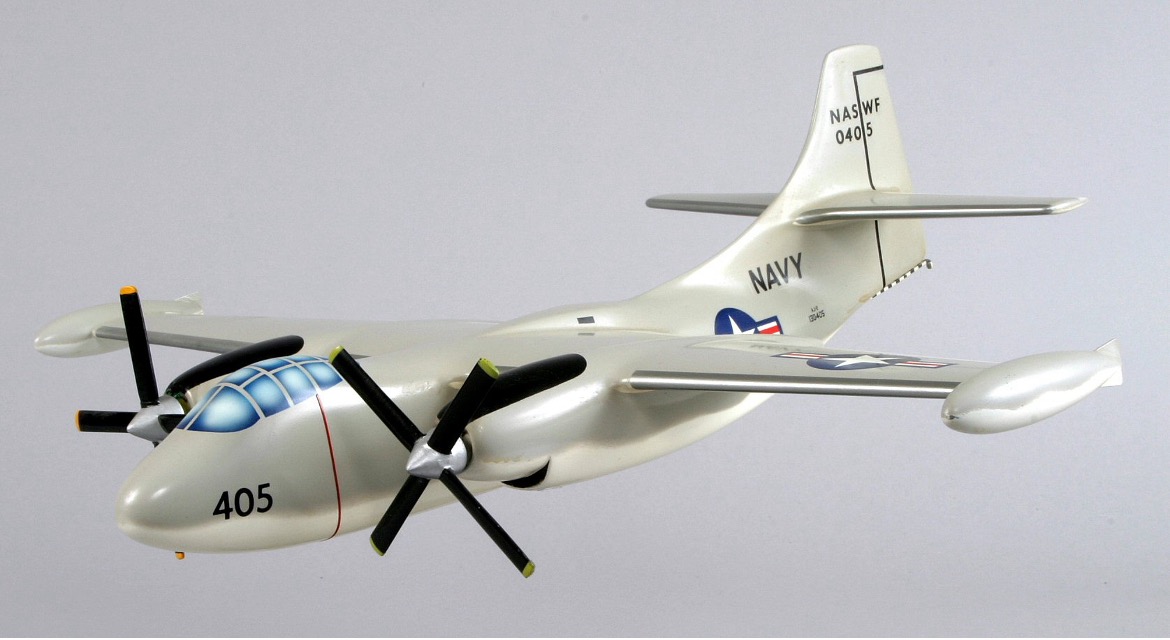USN NASWF North American AJ-1/ A-2 Savage

MODEL BY:
H. Davidson
Model Scale:
1/48
MODEL ADDED:
N/A
historical significance
First Albuquerque Visit: 1950
Additional Information:
The North American AJ Savage (later A-2) was an American carrier-based medium bomber built for the United States Navy by North American Aviation. The AJ-1, designed shortly after World War II, was a three-seat, high-wing monoplane with tricycle landing gear designed to carry atomic bombs. As the heaviest aircraft thus far designed to operate from an aircraft carrier, the AJ was powered by two piston engines and a turbojet buried in the rear fuselage.
To facilitate carrier operations, the AJ’s outer wing panels and the tailfin could be manually folded. The aircraft came equipped with two 2,300-brake-horsepower Pratt & Whitney R-2800-44W Double Wasp piston engines, mounted in nacelles under each wing with a large turbocharger fitted inside each engine nacelle, and a 4,600-pound-force Allison J33-A-10 turbojet that was located in the rear fuselage. The jet engine was only intended for takeoffs and when the maximum speed was needed at the drop zones. The turbojet was fed by an air inlet on the top of the fuselage that was normally kept closed to reduce drag on the aircraft. The AJ-1 first became operational in 1950 and 143 were built before being replaced by the Douglas A3D Skywarrior beginning in 1957.
Albuquerque’s Kirtland Field was designated Kirtland Air Force Base in 1947, and the Armed Forces Special Weapons Project (AFSWP) operated on Sandia Base. When the United States Air Force established the Air Force Special Weapons Command at Kirtland Air Force Base in 1949, the United States Navy formed a detachment to investigate nuclear capabilities for naval aircraft and assist the AFSWP with naval equipment for demonstrations and training. The Naval Weapons Evaluation Facility (NWEF) operated through the Cold War investigating aircraft-weapon interfaces to provide United States Navy aircraft with nuclear weapons delivery capability.
In 1952 this detachment was designated the Naval Air Special Weapons Facility (NASWF) to conduct special weapons tests on the White Sands Missile Range and Tonopah Test Range in coordination with the United States Atomic Energy Commission. In March of 1961, the NASWF was re-designated the Naval Weapons Evaluation Facility (NWEF) and its mission was expanded to include safety studies on nuclear weapons. The aircraft used for NWEF testing were decorated with the NWEF thunderbird symbol and the NWEF detachment became known as the Rio Grande Navy by its sailors and civilians.
In 1992, with the consolidation of many naval activities and the drawdown of the U.S. defense budget, NWEF became part of the large, multisite Naval Air Warfare Center Weapons Division in China Lake. In 1993 the NWEF was decommissioned and became the first nuclear-weapons-related facility in the Free World to be shut down. As NWEF closed, it transferred some of its remaining people and functions to the China Lake site.
The North American AJ-1 Savage, Bu Nos. 124169 and 151646, was assigned to the Naval Air Special Weapons Facility (NASWF) at Kirtland Air Force Base in Albuquerque, New Mexico, for special weapons suitability tests in 1950.
GALLERY:
SEARCH OUR DATABASE:
